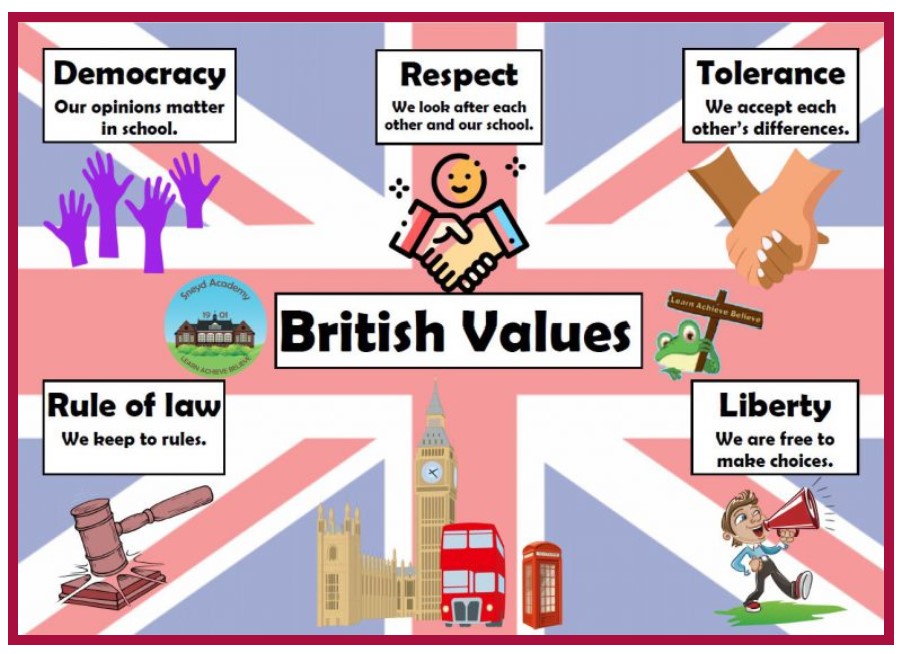Equality, Diversity, SMSC & British Values
British Values
We teach 5 Fundamental British Values to our children and staff.
The government set out its definition of British values in the 2011 Prevent Strategy, encompassing values of:

Schools have always promoted British Values. Whilst the Prevent Strategy defined specific values, the following documents have always enabled schools to develop them for their communities:
- The Human Rights Act 1998
- The Data Protection Act 1998
- Freedom of Information Act 2000
- The Equality Act 2010
Spiritual, Moral, Social, and Cultural development (SMSC)
SMSC in our Curriculum can be found here.
Equality and Diversity
We are committed to equality and valuing diversity, and actively supports practices that promote genuine equality of opportunity for all staff and children. We recognise our obligations under the Equality Act 2010 and are committed to promoting the equality and diversity of all those we work with especially our employees, pupils, young people and visitors. We comply with the Special Educational Needs and Disability Regulations 2014 and make our curriculum accessible for those with disabilities or special educational needs.
We aim to meet our obligations under the public sector equality duty by having due regard to the need to:
• Eliminate unlawful discrimination, harassment and victimisation and other conduct that is prohibited by the Equality Act 2010;
• Advance equality of opportunity between people who share a protected characteristic and people who do not share it; and
• Foster good relations across all characteristics – between people who share a protected characteristic and people who do not share it.
PROMOTING THE NINE PROTECTED CHARACTERISTICS
We strive to ensure our children understand that:
There are no outsiders at BPS......
Everyone is different.....
We celebrate difference.....
We are all equal in our differences....
The Equality Act became law in 2010. It covers everyone in Britain and protects people from discrimination, harassment and victimisation. Everyone in Britain is protected.
Under the Equality Act, there are nine Protected Characteristics:
The 9 Protected Characteristics are actively promoted in school through:
- Our school vision and ethos statements, SDP, and SEF
- Our school core values: Ready, Respectful, Safe
- Our school behaviour policy
- Conscious role modelling by all adults in the school community
- Active engagement and communication with parents and carers
- Assemblies
- The promotion of British values in school life
- Developing a love of reading through a range of authors and genres
- Discussion within curriculum subjects, taking a cross-curricular approach, for example when we learn about Black History month and when we learn about relationships in RSE
- Promoting articulation by building appropriate language and a coherent vocabulary
- Personal, Social, Health and Economic education (PSHE) sessions (Our Learning for Life PSHE curriculum)
- Religious Education (RE) lessons and RSE lessons
- Sporting competitions –inter and intra competitions
- Art projects and visits
- School Council
- Educational experiences and visits
- Real-life learning outside the classroom
- Guest speakers
- Developing links with the local community
- Extra-curricular activities, after-school clubs, charity work and work within the local community
- Safer recruitment, retention and staff development
We collect and analyse the following data to assess the impact of our Single Equality Policy. The data is recorded on our CPOMs system and the main areas we assess are:
- Admissions, Attendance, Exclusions and Outcomes
- Child-on-child abuse and Unsafe online behaviours
- Racial incidents, Bullying incidents and Homophobic incidents
- Any other prejudice related incidents
- Sexual Violence and Harassment incidents
We champion diversity and inclusion and embed the Protected Characteristics into the whole school ethos at BPS by:
- Embedding a values-based curriculum
- Delivering whole school assemblies that are linked to diversity and equality, promoting the protective characteristics including high quality texts which promote diversity and inclusion
- Reading and discussing picture books and stories encourages respect and developing an understanding of diversity.
